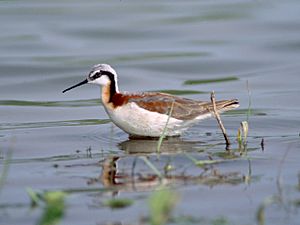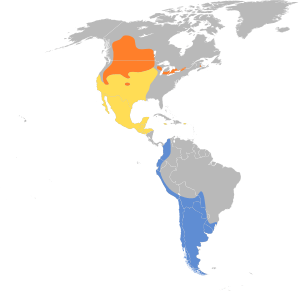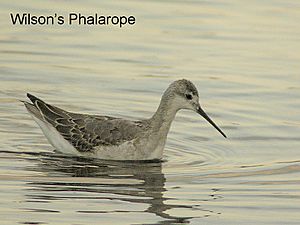Wilson's phalarope facts for kids
Quick facts for kids Wilson's phalarope |
|
|---|---|
 |
|
| Female (breeding plumage) | |
| Conservation status | |
| Scientific classification | |
 |
|
| Synonyms | |
|
Steganopus tricolor |
The Wilson's phalarope (Phalaropus tricolor) is a small bird that lives near water. It is the biggest type of phalarope. These birds breed, or have their babies, in the prairies of North America. You can find them in western Canada and the western United States.
Wilson's phalaropes are migratory birds. This means they travel long distances. They spend their winters near salty lakes in Argentina, close to the Andes mountains. They also fly through Central America in spring (March/April) and fall (September/October). Sometimes, they are seen in western Europe, but this is very rare.
These birds are often quite calm and easy to approach. Some scientists place this bird in its own special group called Steganopus.
Contents
What's in a Name?
This bird is named after Alexander Wilson. He was a Scottish-American bird expert.
The name "phalarope" comes from old French and Latin words. These words mean "coot" and "foot." Both coots and phalaropes have special lobed toes. These toes help them swim. The word tricolor means "three colors" in Latin. This refers to the different colors on the bird.
About the Wilson's Phalarope
The Wilson's phalarope is a bit bigger than the red phalarope. It is about 23 centimeters (9 inches) long. It is a graceful shorebird with lobed toes and a thin, straight black beak.
When breeding, the female bird is mostly gray and brown on top. Her belly is white. She has a reddish neck and reddish patches on her sides. The male bird looks similar but is not as brightly colored. His back is brown, and his reddish patches are smaller or missing.
Measurements:
- Length: About 22-24 cm (8.7-9.4 inches)
- Weight: About 38-110 grams (1.3-3.9 ounces)
- Wingspan: About 39-43 cm (15.3-16.9 inches)
Studies in Saskatchewan, Canada, showed that female phalaropes are usually larger. They are about 10% bigger and weigh about 30% more than males. Females weigh around 68 to 79 grams (2.4 to 2.8 ounces). Males weigh about 51.8 grams (1.8 ounces).
Young phalaropes are gray and brown on top. Their undersides are whitish. They have a dark patch around their eyes. In winter, their feathers are mostly gray on top and white below. But they always keep the dark eye patch. These birds can live for about 10 years in the wild.
Life and Habitat
Wilson's phalaropes love salty places. They are called halophilic birds. Many of them gather at salty lakes during migration. Some of these lakes include Mono Lake in California, Lake Abert in Oregon, and the Great Salt Lake in Utah. They often feed with red-necked phalaropes there.
When a Wilson's phalarope feeds, it often swims in fast, small circles. This makes a tiny whirlpool in the water. This whirlpool helps bring small insects or crustaceans up from the bottom. The bird then reaches into the swirling water with its beak to catch its food.
Reproduction and Roles
In phalarope species, the usual bird roles are switched! The females are larger and have brighter colors than the males. The females chase males and compete for good nesting spots. They also bravely protect their nests and chosen mates.
Once the females lay their eggs, they start their journey south. They leave the males to sit on the eggs and care for them. Females lay three to four eggs in a nest on the ground, usually near water. The young birds can find their own food.
Population Status
Wilson's phalaropes are still very common. However, their numbers might be going down in some areas. This is because their wetland homes in the prairies are disappearing. A few special places are very important for them during their long migration journeys.
See also
 In Spanish: Falaropo tricolor para niños
In Spanish: Falaropo tricolor para niños



